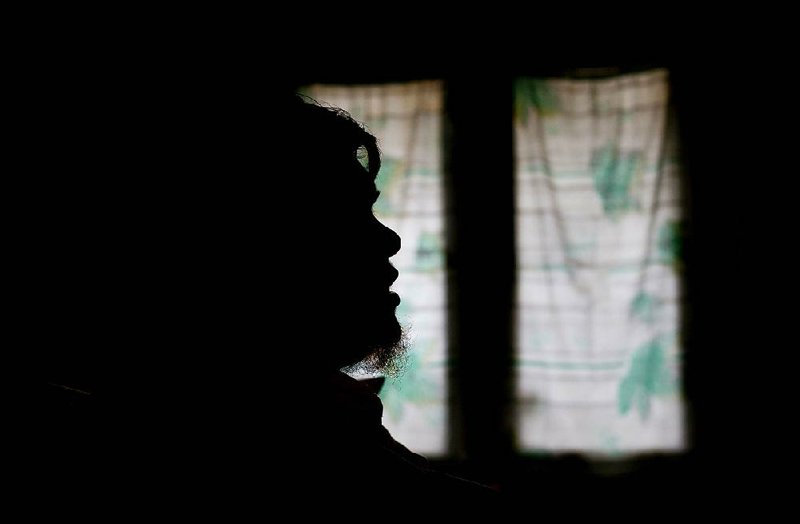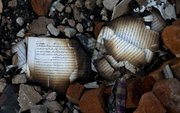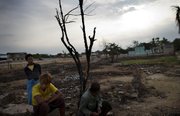MEIKHTILA, Burma - Their bones are scattered in blackened patches of earth across a hillside overlooking the wrecked Islamic boarding school they once called home.
Among the smashed fragments of skull and jaw lie the sharpened bamboo staves attackers used to beat dozens of people to the ground before drowning their still-twitching bodies in gasoline and burning them alive.
The mobs that March morning were Buddhists enraged by the killing of a monk. The victims were Muslims who had nothing to do with it - students and teachers from a prestigious Islamic school in central Burma who came so close to being saved. In the last hours of their lives, they only had to make it a few hundred steps, to four police trucks waiting on a hill above.
What happened on the way is the story of one of Burma’s darkest days since this Southeast Asian country’s post-junta leaders promised the dawn of a new, democratic era two years ago - a day on which 36 Muslims, most of them teenagers, were slaughtered before the eyes of police and local officials who did almost nothing to stop it.
The day before the massacre began like every other at the Himayathul Islamic Boarding School in Meikhtila - with a call to prayer echoing through the darkness before dawn.
It was March 20, a Wednesday, and 120 drowsy students blinked their eyes, rising from a sea of mats spread across a vast dormitory.
When classes began, student gossip quickly turned to an argument in town between a Muslim gold merchant and a Buddhist client, which had prompted a crowd of hundreds to overrun the shop and set it ablaze.
That afternoon, several Muslim men yanked a monk off a motorcycle and burned him to death. Buddhist mobs in turn torched Muslim businesses and 12 out of 13 of the city’s mosques.
Classes at Himayathul were canceled. Students rushed to the dormitory’s second floor and gazed out of the windows in shock at the black and gray columns of smoke.
As the sun slunk in a hazy sky, a Buddhist government administrator came to the madrassa and took the headmaster aside.
“You need to get your students out of here,” he warned. “The mobs are coming - tonight.”
At sunset prayers, the headmaster told everyone to collect their valuables and their money, remove their head caps and Islamic dress and prepare to leave. He never explained why. He didn’t have to.
“If they try to destroy this place, we’ll do our best to stop them,” he said. “But whatever happens, we will not let you die.”
FEAR IN THE DARK
They crept deep into a swampy square of tall grass called the Wat Hlan Taw after dark. Most of the 150 refugees were students and teachers, but two dozen women and children were among them.
They sat down in the mud. Nobody said a word.
Soon they heard a cacophony of voices, first at the gate of their madrassa and then inside. The mobs kicked in doors, smashed windows and set the place on fire.
In the darkness of the Wat Hlan Taw, a teacher named Shafee with a stomach ailment reached for his wife’s palm and squeezed it hard.
“If they find us …” he whispered nervously, “you know I won’t be able to run.”
“Don’t worry,” his wife, Thida, replied, cradling their 3-year-old son in her arms. “We’ll be together, every step.”
At 4 a.m., Buddhist prayer gongs rang out, and the mobs began shining flashlights into the Wat Hlan Taw, screaming, “Come out, Kalars!” - a derogatory word for Muslims.
By the time students fled to a neighboring compound owned by a wealthy Muslim businessman, the mobs were not far behind.
Thida heard a boy screaming somewhere behind her. He had waited just a few seconds too long to run.
When the sun rose, students peered over the compound’s thin bamboo fence and realized they were trapped.
Men clutching machetes and sticks were girding for a fight outside. Hundreds more were gathering on a road running across a huge embankment that shadowed the neighborhood’s western edge.
Some students made frantic calls for help. Some chanted and prayed. Others scoured the property for wooden boards and rocks with which to defend themselves.
When opposition lawmaker Win Htein arrived around 7:30 a.m., he saw dozens of helmeted riot police equipped with rifles and gray shields. They had formed lines to keep the Buddhist hordes away from the Muslims.
Over the next 45 minutes, though, he watched in horror as mobs chased five more students out of the bush, one by one, and bludgeoned them to death. Stone-faced police officers stood idle just steps away.
“They must be wiped out!” one woman shouted, urging the killers on.
When Win Htein tried to convince them to spare the Muslims, the mobs threatened him. An officer advised him to leave.
Shortly after, a monk and four policemen offered to escort the trapped Muslims on foot to police vehicles on top of the embankment.
“We’ll protect you,” one officer said. “But the students must stop chanting. They must put down their weapons” - their sticks and stones.
As the teachers debated what to do, they realized their time had run out. The crowds were flinging long bamboo staves wrapped with burning fabric over the fence like giant matchsticks, and the compound was on fire.
NO SAFE PASSAGE
The group emerged slowly with their hands behind their heads, like prisoners of war.
Almost immediately, they were stoned. The mobs screamed around them.
What followed was a gantlet from hell, an obstacle course that came with its own set of macabre rules: Do not run, or they will chase you. Do not fall, or you may never get back up. Do not stop, or you may die.
Police fired several rounds into the air, but the crowds attacked anyway, clubbing a student across the forehead with a hoe and knocking a teacher to the ground. One officer, struck in the face by a rock, apparently by accident, shot a Buddhist man in the leg.
As they moved inside the Buddhist neighborhood, police ordered the Muslims to squat down.
Crowds taunted and slapped them. Several women forced them to bow their heads and press their hands together in prayer like Buddhists.
The monks said the police should round up the women and children and let them go first. When Thida refused to let go of her husband, a Buddhist man shoved a palm in his face and forced them apart.
Eventually, police began escorting about 10 women and their children up the hill toward the trucks. But even as they ascended, other Buddhists hacked a 17-year-old student to death on the edge of the Wat Hlan Taw, striking him 24 times. One of the attackers was a monk.
“Look! Look!” one Buddhist bystander shouted from the top of the embankment. “The police are heading down there, but they aren’t doing anything.”
The last time Thida saw her husband, he was struggling to climb the hill to where she waited anxiously beside police.
His face was pale. And voices were screaming out: “Kill the Kalar! Don’t leave any of them behind!”
Somewhere below, crowds were chasing several students who had tried to run. They beat two of them, along with a teacher, to the ground with daggers and sticks. Police stood on both sides of the hill watching, unmoved.
When a frantic monk waved a multicolored Buddhist flag, screaming for the killing to stop, the crowds backed away briefly.
But police left the wounded behind on the hill, abandoning them to their fate.
MOB VIOLENCE
A video clip shows a man viciously beating a group of seven bloodied Muslim men as they lay crumpled on the ground beneath a grove of rain trees. One of them is Shafee.
“Oh, you wanna fight back?” a voice says, laughing.
Another grainy video filmed shortly after shows flames leaping from 12 charred corpses in the same spot, as crowds cheer.
Smelling burning flesh, Thida hugged the leg of a police officer standing beside her.
“Hey brother,” she asked, “please. Please. What is happening to us?”
“Shut up, woman,” the officer replied. “Don’t you know you can die here, too?”
Amid the mayhem, several dozen police reinforcements arrived to take the remaining Muslims to the hilltop and load them onto the trucks. The survivors were driven to a police station, where they were offered water and, by at least one officer, an apology.
The police present that day were the only ones with rifles and guns, which would have been no match for the crude weapons carried by the mobs. But while they rescued about 120 Muslims, they did not stop the massacre of 32 students and four teachers.
Win Htein, the lawmaker, said either the “police didn’t get any order from above [to shoot], or they got the order from above not to do anything.”
The head of state security in the region, Col. Aung Kyaw Moe, insisted he gave authorization to fire, but police held back because doing so could have “made the situation even worse.”
He said even though 200 police were deployed to the area, the crowds outnumbered them. Muslims died because “some of them tried to run,” he said.
“They scattered and our forces could not follow every one of them,” he said. “They had to take care of the rest of the people they were guarding … that’s why there were casualties.”
Authorities say they did not hand the bodies back to the relatives of the dead because they were too badly burned to be identified. But families of those slain say they were never even asked, and never given the chance to bury their loved ones according to Islamic rites.
The school’s headmaster dreams of gathering his surviving students together again and rebuilding his school elsewhere.
He will not say where, or when. He is too afraid.
He wonders what they will do if sectarian violence erupts again.
“Where is safe in this Myanmar?” he says.
Ruling military authorities adopted the name Myanmar for Burma in 1989. Aung San Suu Kyi and other opponents of the military regime refused to adopt the name change, as have the U.S. and Britain.
On March 21, the headmaster urged his students not to fight back.
“Next time, we will defend ourselves,” he says quietly, “because we know that nobody else will.” The Associated Press pieced together the story of the March 21 massacre from the accounts of 10 witnesses, including seven survivors who only agreed to meet outside their homes for security reasons. The AP crosschecked their testimony against video clips taken by private citizens, many with the date and time embedded; public media footage; dozens of photos; a site inspection, and information from local officials.
Religion, Pages 12 on 07/27/2013



